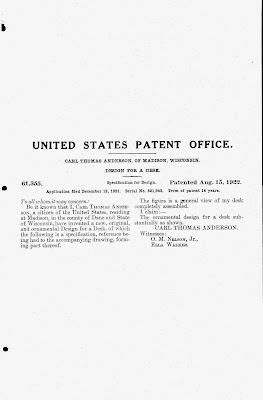But one of the things that often gets lost when discussing cartoonists from Richard Outcault to Charles Schulz to Stephan Pastis is their lives outside of cartooning. These people are all multi-faceted individuals, and pursue interests beyond what they're famous for. Even in David Michaelis' comprehensive biography Schulz and Peanuts, he continually resorts to tying the events in Schulz's life to what happened in the strip.
So it's kind of interesting to come across items that aren't directly related a cartoonist's comic strip. In the case of Anderson, he actually holds a design patent in the U.S. for a desk he created. He was actually a carpenter before becoming a cartoonist and used those skills in his 50s to craft a different design for a desk. The patent filing isn't terribly elaborate in its description, but it includes a wondefully done illustration...


My best guess is that it doesn't "fold", so much as "come apart easily." I suspect the legs and the drawing surface itself aren't actually connected, but are held in place with friction and gravity. This would certainly require a bit more ingenuity and craftsmanship than simply screwing the pieces together, and points to Anderson's continued interest in carpentry decades after he supposedly would have given it up.
Not a huge discovery, but a fascinating contextual one that puts a more colorful light on someone who might otherwise be thought of as just a cartoonist.







3 comments:
Okay, but, I'm perplexed by a couple of points about Anderson's cartooning.
What was Raffles and Bunny? Those are the names of the two leads in Hornung's Raffles stories. I presume a comic strip of the same name must have been some kind of reference. But quick searching has failed to turn up any details of the strip. If it was an adaptation, that seems important to mention. (Whether it was licensed, or no.)
Meanwhile, "the amateur cracksman" is Raffles's unofficial title. But Anderson used it for a character named "Herr Spiegelberger?" After creating a Raffles and Bunny comic strip?
What? What's going on with any of this?
Doing some more digging, the titles were jumbled in the source I used for that bit. (Wikipedia can be wrong?!?) Looking them up in Holtz's encyclopedia of newspaper comics, the titles were in fact Raffles and Bunny, the Amateur Cracksman and Herr Spiegelberger.
I don't have much info on the Raffles comic. It's listed by Holtz as a Sunday-only strip that ran from February through October 1903. It was syndicated through New York World, but I don't know how widely. With that very specific title, I have to assume it's either a direct adaptation or an attempt at a continuation of some kind.
Herr Spiegelberger was also a Sunday-only, but ran from 1901-1906. No idea what the content was there, though. Some blurry online images suggest it was a pretty standard (for the day) gag strip.
Okay, this information definitely makes more sense. Thanks! :-)
Post a Comment